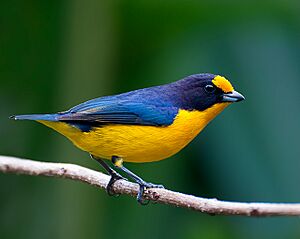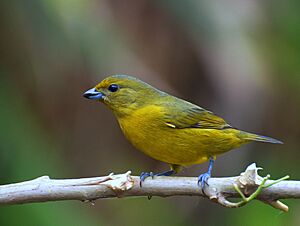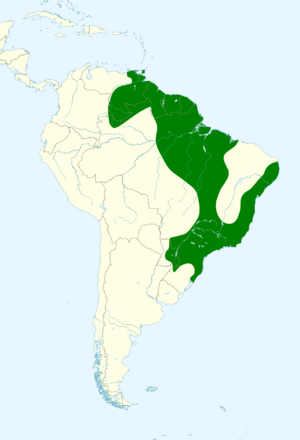Violaceous euphonia facts for kids
Quick facts for kids Violaceous euphonia |
|
|---|---|
 |
|
| Male | |
 |
|
| Female | |
| Conservation status | |
| Scientific classification | |
| Genus: |
Euphonia
|
| Species: |
violacea
|
 |
|
| Synonyms | |
|
|
The violaceous euphonia (Euphonia violacea) is a small, colorful bird. It belongs to a group of birds called passerines, which are also known as perching birds. This bird is part of the true finch family. It lives all year round in its home range, which stretches from Trinidad, Tobago, and eastern Venezuela down to Paraguay and northeastern Argentina. You can also find it in northern Brazil, especially near the Amazon Basin and the Tocantins River.
Contents
Where They Live
The violaceous euphonia likes to live in forests. You can also find it in areas where trees have grown back after being cut down, and in farms that grow cocoa and citrus fruits. These birds are quite social and often seen together.
What They Look Like
Adult violaceous euphonias are about 11.4 centimeters (about 4.5 inches) long. They weigh around 14 grams, which is about as much as a few quarters.
- The male violaceous euphonia is very striking. Its upper body is a shiny blue-black color. It has a bright golden yellow forehead and belly.
- The female and young birds look different. They are olive green on their backs and greenish yellow on their undersides. This helps them blend in with the leaves.
What They Eat
Violaceous euphonias mostly eat small fruit. They especially like fruits from mistletoes, epiphytic cacti (cacti that grow on other plants), and Cecropia trees. Their bodies are well-suited to digest these simple fruits. They only eat insects rarely. Sometimes, in Brazil, they have even been seen eating small land snails!
Sounds and Songs
The song of the violaceous euphonia is quite varied. It's a mix of musical notes, little squeaks, chattering sounds, and sometimes they even imitate other birds.
Reproduction and Life Cycle
These birds build their nests in interesting places. They make a ball-shaped nest on a bank, inside a tree stump, or in a natural hole. A female violaceous euphonia usually lays four eggs, but sometimes just three. The eggs are white with red spots. The female bird sits on the eggs to keep them warm until they hatch.
Conservation
Some birds in the Euphonia group are caught and kept as pet birds, which can be a problem for their numbers. However, the violaceous euphonia is doing well. Its natural home is often in places that are hard for people to reach, which helps protect it.


